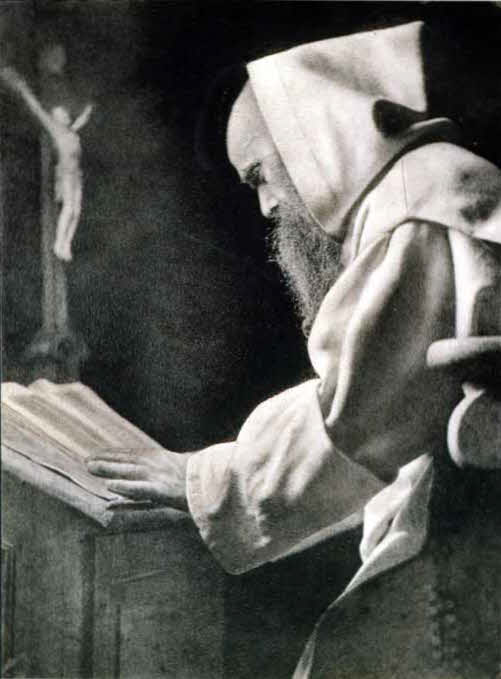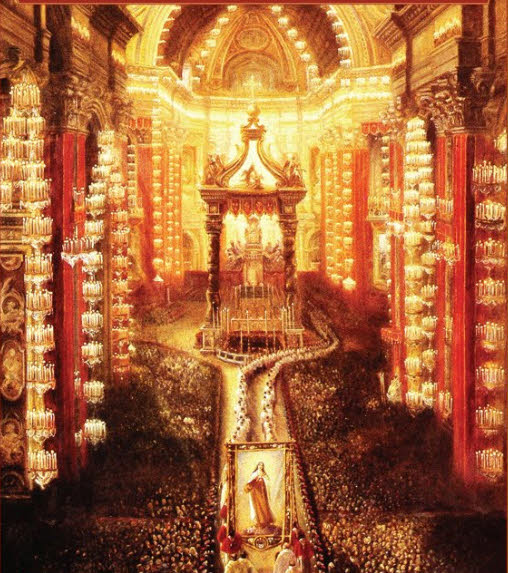|
Plinio Corrêa de Oliveira
AMBIENCES, CUSTOMS,
CIVILIZATIONS Harmonious Extremes in the Firmament of the Church
Catolicismo Nº 96 - December 1958 |
|
|
An aspect of Holy Church: In a semi-dark cell, before a crucifix reminiscent of the most painful death there ever was, a Carthusian Monk leafs through a devotional book. Clad in a simple and poor habit, with a long beard, this man religious seems the personification of all the elements that permeate the environment that surrounds him: extreme gravitas, manly resolve to live only for what is profound, true and eternal; noble simplicity, spirit of renunciation of all things earthly, material poverty illuminated by supernatural reflections of the highest spiritual wealth. * * *
Another aspect of Holy Church: A papal cortege proceeds majestically in the immense central nave of St. Peter's Basilica. In the photograph we see only a part of it, that is, some cardinals and ecclesiastical and lay dignitaries who immediately precede the gestatorial chair with the Supreme Pontiff, flanked by the famous flabelli and followed by the Noble Guard. In the background stands the Altar of Confession with its elegant columns and splendid canopy. And well behind it one sees Bernini's famous “Gloria”. The high walls, covered with admirable marbles and adorned with reliefs, the arches at once light and immense, the lights that shine like stars or glittering diamonds, everything is endowed with a grandeur and wealth that is the quintessence of all beauty the earth is able to present. It is the greatest pomp of which man is capable, enhanced by the magnificence of art and by the natural splendor of stone. * * * In the first picture one sees recollected gravitas; in the second, radiant glory. In the former, poverty; in the latter, splendor. In one, simplicity, in the other, refinement. In the first, a renunciation of creatures; in the second, a superabundance of most splendid creatures. Is that a contradiction? Many would say so: how can you love at one and the same time, wealth and poverty, simplicity and pomp, ostentation and recollection? Can you praise at the same time the abandonment of all things earthly and gather them all to compose a picture in which the highest earthly values shine? The problem is very current as His Holiness Pope John XXIII shows himself so edifyingly zealous of the splendid traditions of the Vatican, to the manifest disconcert of people with a mentality like Aneurin Bevan’s (a leading labor leader in the fight against all pomp who turned its back while attending part of Queen Elizabeth II’s coronation ceremony). No, there is no contradiction between the two orders of values except in the minds of egalitarians, servants of the Revolution. On the contrary, the Church shows herself holy precisely because, with equal perfection and the same supernatural genius she knows how to organize and stimulate the practice of virtues that shine both in the obscure life of a monk and in the sublime ceremonial of the Papacy. Even more, one thing balances the other. We could almost say that one extreme (in the good sense of the word) compensates for the other and is reconciled with it. The doctrinal background on which these two holy extremes meet and harmonize is very clear. God our Lord gave us creatures so they may help us reach Him. Thus, culture and art, inspired by the Faith, should bring to light all the beauties of irrational creation and the splendors of talent and virtue of the human soul. This is what is called Christian culture and civilization. With this, men are formed in truth and beauty, in the love of sublimity, hierarchy and order, which mirror, in the universe, the perfection of Him who made it. And so creatures actually serve for our salvation and for divine glory. On the other hand we should remember that they are contingent and fleeting; only God is absolute and eternal. This is why it is well to take a distance from created beings and despise them to think only about the Lord. In the first way, by considering all that the creatures are one rises up to God; in the second, one rises to Him by considering what they are not. The Church invites her children to tread both ways simultaneously through the sublime spectacle of her pomp and through the consideration of the admirable renunciations that She alone knows how to inspire and make effective. |
|



